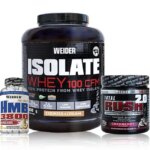
Returning to the less scientific articles and something more specific about a product or ingredient in particular, in this article I found it very interesting to talk a little more deeply about a very good supplement that is coming back to hit hard among athletes in general and strength athletes in particular, this is the HMB which is the first name of the β-Hydroxy-β-Methyl-Butyrate.
I'm sure you've heard of it, but there is a bit of controversy about its effects and its mechanisms of action, so much so that these mechanisms are still not exactly known. Well, that's not what matters to us, because the interesting thing is the effects it produces and how they can help us to make progress.
What is HMB?
It is the abbreviation for the acid β-Hydroxy-β-MethylButanoic acidwhose stable and marketable form is calcium salt, i.e. the β-Hydroxy-β-Methyl-Butyrate of calcium, which we know as HMB. The HMB is a metabolite of the branched-chain essential amino acid leucine. This means that it is halfway between the original amino acid, Leucine, and the end product of its metabolisation, HMG-CoA (Hydroxy Methyl Glutaryl-CoA) which can ultimately degrade to Acetoacetate or Acetyl-CoA.
How does it act and what processes is it involved in?
It appears that leucine and its metabolites may decrease protein degradation. The mechanism of action of leucine and its metabolites is not yet clear. HMBbut what has been shown is that it is involved in the repair and growth processes of muscle cells.
There is evidence that it is involved in the protection of muscle proteins during intense and/or prolonged exercise and accelerates their subsequent repair.
The HMB had been proposed to increase muscle mass and strength, but scientific evidence suggests that the cause-effect is not direct, i.e. that the intake of HMB does not directly imply an increase in muscle mass and/or strength, but by avoiding damage and protein degradation (catabolism) and accelerating recovery, it indirectly predisposes us to an improvement in our strength and an increase in our muscle mass, as long as the diet and rest periods are adequate.
How to use HMB?
That being said, normally, the intakes of HMB are between 1.5 and 3.5 grams per day, which is equivalent to taking 2 to 4 capsules of HMB 3800of Weider. Or if we prefer to adjust it to body weight, between 40 and 50 mg/kg body weight per day.
- In strength athletes: it seems that the effect of the HMB The amount of time it is taken decreases over time, i.e. after a few weeks of use (about 2 months). This is why I recommend taking it mainly at two points in time:
- First and foremost, when you increase your training volume or intensity. For example, in volume phases or in pre-competitive or strict dieting moments.
- The second is when we return to training after a period of rest or after an injury.
- In endurance athletes: because it helps to prevent muscle degradation in runners, improving the athlete's adaptations to training. It improves recovery between efforts, which is why its consumption is recommended to minimise muscle damage as a result of running (eccentric contractions) and because it improves the regeneration/repair capacity of tissues.
- In novice athletes: both strength and endurance, so we could include all of them here, i.e. also team sports, racket sports, etc. As I mentioned before, it seems that studies show a greater effect on beginners than on trained individuals. So we can say that all those who are just starting out can benefit from the effects already described from the HMB.
- In the elderly: because muscle atrophy and degradation is accentuated at this stage of life, the HMB has been shown to minimise these effects in people aged 60 and over.
Combinations between HMB and other supplements?
- HMB + Creatine: It seems that by combining them, the effects of both are enhanced. Thus within the whole range of products we can choose to combine the HMB 3800 with Pure Creatine (Creatine Monohydrate Powder) from Victory. Or to dose in a more convenient way with Maximum Krea-Genic by Weider. Although I still insist (because I already talked about it in MuscleStars issue number 4!) on one of the star products that combines HMBwith Creatine and other ingredients such as L-Glutamine, beta-Alanine, etc. is the Myo Gain which, with 800 mg of HMB per dose, we can complete your intake with 2/3 more capsules of HMB 3800.
- HMB + L-Arginine + L-Glutamine: This combination has been used in clinical and hospital nutrition because it appears to produce an increase in fat-free weight and improve the immune system. It also prevents protein degradation due to muscle atrophy in post-operative, trauma and immobilised people. The approximate proportions of each ingredient are 1:4:4.
- HMB + alpha-keto-isocaproic acid: This acid is also a metabolite of leucine and it appears that the combination of these two intermediates of leucine degradation may enhance the reduction of symptoms and signs of exercise-induced muscle damage in bodybuilders.
- HMB + beta-Alanine: This is also a very interesting combination due to the synergy of both molecules in terms of their purpose, but different in the means of action. This minimises post-workout muscle discomfort and accelerates the repair of muscle damage. I insist that the Myo Gain already combines them.
- Well, with all of the above, I think it is more than clear why the use of the HMB as a supplement to improve muscle strength, recovery and body composition. Don't think twice and try a new supplement this new season.
And remember, whether or not you achieve your goals is up to you, the secret is Training, Diet and Supplementation (TDS).





